!Eye Carumba!
3:30 pm, been here since noon. I'm on about page 90- Marriages 1939.
There's at least 10 pages of death records left too. We're shooting for just 100 pages, so I'm trying to take out all the extra tabs that happened when I brought the marriages into Adobe InDesign from Microsoft Word. What a headache.
We have a comittee meeting This Tuesday night and everybody wants this thing done ASAP, and I don't blame them. I told them Mothers Day. I'm not thinking I'll make it by this Tuesday, but at least I know that it will be a lot sooner than Mother's Day.
Prom, Track Meets, and a heckuva lot of yearbook to go in basically 3 more weeks of school...yike.
Gotta get back to it. I told my wife I would try to not be gone all day.
Happy 68th wedding anniversary, Emil Ole Bolduan & Amelia Alvina Jensen!
Sunday, April 30, 2006
HISTORY OF ST. JOHN Part 5
Note: For those readers who are new to "blogs," the first thing posted is the lowest item on a page, so to read part 1 you'll need to "scroll down," or eventually click on the "Previous Posts," or even the "Archives" to read this history from the beginning.
HISTORY OF ST. JOHN
Part 6~ the 1960's
• January 1960, a scholarship fund was created by the congregation to assist young men and women of the congregation to prepare themselves for work in His Kingdom. Charity Sunday was instituted and a portion of the receipts was assigned to the scholarship fund. (On the 3rd Sunday of each month, the offering not included in envelopes, is used for benevolent purposes).
• October 1960, a motion passed that any voter 70 years and over was to become an honorary voting member and his absence was not counted toward quorum.
• In 1962, a portion of adjoining land was purchased from Louis Schultz and added to the cemetery
• July 1967, Pastor O.R. Schlegelmilch accepted a call to Peace Lutheran Church, Columbus, Nebraska. Pastor E.T. Lange, St. Paul, Ute served as vacancy pastor.
• December 15, 1968, Pastor A.I. Prouty of Detroit, Michigan, accepted a call from St. John and was installed.
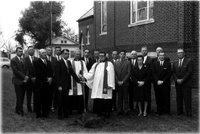 • In 1968, a fact-finding committee was formed to consider plans for a new parsonage or church office. April 1969, plans were approved to build a new church office addition. Ground breaking was in October of 1969 and cornerstone-laying ceremonies were held in July 1970.
• In 1968, a fact-finding committee was formed to consider plans for a new parsonage or church office. April 1969, plans were approved to build a new church office addition. Ground breaking was in October of 1969 and cornerstone-laying ceremonies were held in July 1970.
• In 1969, Carillon bells were installed as a memorial.
• In 1970, Paul Clausen designed and built the communion rail as a memorial. About this same time, a set of communion ware with individual cups was received as a memorial. The set consisted of a stack of wooden trays to hold the individual glass cups, a matching wafer tray and both have matching covers. For some time communion was offered from either the common cup or individual cups – personal choice.
HISTORY OF ST. JOHN
Part 6~ the 1960's
• January 1960, a scholarship fund was created by the congregation to assist young men and women of the congregation to prepare themselves for work in His Kingdom. Charity Sunday was instituted and a portion of the receipts was assigned to the scholarship fund. (On the 3rd Sunday of each month, the offering not included in envelopes, is used for benevolent purposes).
• October 1960, a motion passed that any voter 70 years and over was to become an honorary voting member and his absence was not counted toward quorum.
• In 1962, a portion of adjoining land was purchased from Louis Schultz and added to the cemetery
• July 1967, Pastor O.R. Schlegelmilch accepted a call to Peace Lutheran Church, Columbus, Nebraska. Pastor E.T. Lange, St. Paul, Ute served as vacancy pastor.
• December 15, 1968, Pastor A.I. Prouty of Detroit, Michigan, accepted a call from St. John and was installed.
 • In 1968, a fact-finding committee was formed to consider plans for a new parsonage or church office. April 1969, plans were approved to build a new church office addition. Ground breaking was in October of 1969 and cornerstone-laying ceremonies were held in July 1970.
• In 1968, a fact-finding committee was formed to consider plans for a new parsonage or church office. April 1969, plans were approved to build a new church office addition. Ground breaking was in October of 1969 and cornerstone-laying ceremonies were held in July 1970.• In 1969, Carillon bells were installed as a memorial.
• In 1970, Paul Clausen designed and built the communion rail as a memorial. About this same time, a set of communion ware with individual cups was received as a memorial. The set consisted of a stack of wooden trays to hold the individual glass cups, a matching wafer tray and both have matching covers. For some time communion was offered from either the common cup or individual cups – personal choice.
Pastors at St. John, 4

Pastor Albert I. Prouty served his vicarage at St. Paul’s church in Chicago Heights, Illinois. Following his graduation from Concordia Seminary, Springfield, Illinois, he has held pastorates at Salem, St. Paul churches at Gurley and Potter, Nebraska, and at Redemption Lutheran Church in Detroit, Michigan*. He is presently semi-retired as a Visitation Pastor for Calvary Lutheran Church in Lincoln Park , Michigan**.
He served from 1968 to 1976 at St. John in Charter Oak. He came back and spoke this past March on the actual 125th anniversary of St. John.
*Redemption Lutheran Church
12411 E 7 Mile Rd
Detroit, MI 48205-2154
(313) 526-5631
**Calvary Lutheran Church
3320 Electric, Lincoln Park, MI 48146
Phone: (313)381-6715 Pamela Francis
Founded in 1924, offers quality education in a Christian environment for students preschool and year-round Christian Day Care 7am-6pm, Monday through Friday. We also house the Wayne County Adult Day Program for the Downriver Area. WORSHIP SERVICES: Saturd
francispm@paxway.com
Still at it
I came in to school today to work on the history book. As I take a break to write this I'm on page 69 out of 100. But basically pp. 46 on have been lists of names.
This is the kind of thing I'm doing righn now; I'm taking text that looks like this:
And trying to make it look like this:
Only without the big line space (it didn't translate well to the web) Tedious, to say the least.
Be that as it may, it is amazing how many people are baptised every year! What a blessing
This is the kind of thing I'm doing righn now; I'm taking text that looks like this:
Dec 23 Debbie Sue Klinker
BAPTISMS CONTINUED...
Dec 25 Jill Marie Butler
1957....page 124
Jan 06 Dean Carl Hollrah
And trying to make it look like this:
Only without the big line space (it didn't translate well to the web) Tedious, to say the least.
Be that as it may, it is amazing how many people are baptised every year! What a blessing
"4There is one body and one Spirit—just as you were called to one hope when you were called— 5one Lord, one faith, one baptism; 6one God and Father of all, who is over all and through all and in all." ~Ephesians 4:4-6
"21and this water symbolizes baptism that now saves you also—not the removal of dirt from the body but the pledge of a good conscience toward God. It saves you by the resurrection of Jesus Christ, 22who has gone into heaven and is at God's right hand—with angels, authorities and powers in submission to him."~1 Peter 3:20-22
Thursday, April 27, 2006
HISTORY OF ST. JOHN Part 4
Note: For those readers who are new to "blogs," the first thing posted is the lowest item on a page, so to read part 1 you'll need to "scroll down," or eventually click on the "Previous Posts," or even the "Archives" to read this history from the beginning.
HISTORY OF ST. JOHN
Part 4~ the 1950's
• Later in 1949, an oil-burning furnace was installed in the parsonage, a stoker in the teacherage.
• In 1950, an Adult Bible Class was scheduled for Sunday mornings.
• In the tense situation (Korea) the following statement was offered by the congregation:
We, the members of St. John congregation, together with the members of our church everywhere, offer the following statement of our deepest feelings and convictions amid the tense crisis now developing in the world: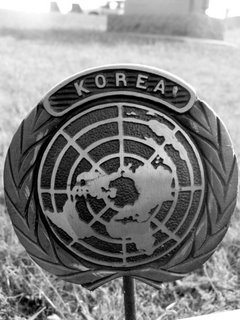
• In 1951, Paul, son of Rev. and Mrs. W. Schroeder, entered St. John’s College, Winfield, Kansas (Saint John's Lutheran College, Winfield, Kansas Opened 1893, closed July 1986), to prepare himself for the ministry, first son of the congregation to do so in more than a quarter of a century. Paul will graduate from Concordia Seminary, St. Louis, Missouri in 1958.
• In 1951, after an intensive program of education and information, $17, 389.75 was contributed to the Sioux City Lutheran Hospital. The Hospital had extended a plea for help, as extensive expansion was necessary to keep the doors of the hospital and training school for nurses open. This is the largest sum ever raised for a purpose other than our own.
• In the fall of 1953, Rev. Schroeder suffered a heart-seizure, which necessitated 7 weeks of idleness. The congregation was very thoughtful and when he was able to resume his work in December, they presented him with the money needed to purchase a fully equipped Chevrolet car with the trade-in of his old car, which had run for more than 90,000 miles. At the end of 1953, to lighten the pastor’s load, the German services were discontinued, except for the Good Friday Communion Service.
• The pastor was unable to serve for 2 months due to illness. He recovered and was able to carry on his work.
• June 3, 1956, was the first service of the Jubilee celebration. Rev. A. Amstein of San Diego, California, the only other resident pastor of St. John during these 75 years, addressed the congregation by means of a taped recording. (His age and failing health prevented his traveling). Student Paul Schroeder of Concordia Seminary, St. Louis, delivered an address emphasizing Christian education. The children of the Kindergarten and 8th grade, capped and gowned, enjoyed a formal graduation in the service.
• On April 15, 1956, St. John congregation numbered: Souls… 1,009; Communicants members … 731; Voting members …126; Children in school…65; and Children in Sunday School…115.
• In 1956, it was decided to participate in and support Lutheran broadcasting on radio K.D.S.N. – Denison. (today "Thy Strong Word" can still be heard on KDSN 107.1 fm/1530 am)
• In 1957, Paul Fiene was presented a plaque commemorating 50 years of service as President of our congregation. He was also voted as lifetime honorary President. (He entered his eternal home in April, 1967)
• In 1957, it was decided to hold Mission Festival twice a year rather than 2 services on one Sunday.
• In July 1957, the congregation went on record to morally and financially support Eventide Lutheran Home for the Aged.
• November 13, 1957, Pastor W.P. Schroeder, after 4 years of declining health, entered his eternal rest. Funeral services were conducted at St. John on November 16. He was laid to rest in St. John Lutheran Cemetery at Charter Oak. He faithfully served St. John for 23 years.
• February 9, 1958, Pastor O.R. Schlegelmilch of Tipton, Indiana was installed as the third Pastor of St. John.
• August 30, 1959, was a special service commemorating 25 years of ministry for Pastor O. R. Schlegelmilch.
HISTORY OF ST. JOHN
Part 4~ the 1950's
• Later in 1949, an oil-burning furnace was installed in the parsonage, a stoker in the teacherage.
• In 1950, an Adult Bible Class was scheduled for Sunday mornings.
• In the tense situation (Korea) the following statement was offered by the congregation:
We, the members of St. John congregation, together with the members of our church everywhere, offer the following statement of our deepest feelings and convictions amid the tense crisis now developing in the world:

1. We sincerely repent of our sins and shortcomings.
2. We trust in Jesus Christ who died that men might live. We are sure that our God is a merciful God as we know Him in Jesus Christ and believe that even now He will forgive our negligence, and avert the looming disaster overshadowing the world.
3. We pray for peace. We ask God to grant harmony to the disunited and oppressed peoples of the earth. We implore Him to make it possible for all nations to solve their differences without armed conflict.
4. We appeal to the leaders of all countries to consider, while there is time, the bitter fruits of war and to weigh every decision with deliberation during these ominous days.
5. We pledge ourselves to stand shoulder to shoulder with our fellow-Americans that the voice of our nation, and if necessary, its arms may be raised for what is right in the sight of God and of the peace of the world.
6. To that end we resolve to dedicate ourselves to earnest, fervent prayer for our country and the peace of the world.
• In 1951, Paul, son of Rev. and Mrs. W. Schroeder, entered St. John’s College, Winfield, Kansas (Saint John's Lutheran College, Winfield, Kansas Opened 1893, closed July 1986), to prepare himself for the ministry, first son of the congregation to do so in more than a quarter of a century. Paul will graduate from Concordia Seminary, St. Louis, Missouri in 1958.
• In 1951, after an intensive program of education and information, $17, 389.75 was contributed to the Sioux City Lutheran Hospital. The Hospital had extended a plea for help, as extensive expansion was necessary to keep the doors of the hospital and training school for nurses open. This is the largest sum ever raised for a purpose other than our own.
• In the fall of 1953, Rev. Schroeder suffered a heart-seizure, which necessitated 7 weeks of idleness. The congregation was very thoughtful and when he was able to resume his work in December, they presented him with the money needed to purchase a fully equipped Chevrolet car with the trade-in of his old car, which had run for more than 90,000 miles. At the end of 1953, to lighten the pastor’s load, the German services were discontinued, except for the Good Friday Communion Service.
• The pastor was unable to serve for 2 months due to illness. He recovered and was able to carry on his work.
• June 3, 1956, was the first service of the Jubilee celebration. Rev. A. Amstein of San Diego, California, the only other resident pastor of St. John during these 75 years, addressed the congregation by means of a taped recording. (His age and failing health prevented his traveling). Student Paul Schroeder of Concordia Seminary, St. Louis, delivered an address emphasizing Christian education. The children of the Kindergarten and 8th grade, capped and gowned, enjoyed a formal graduation in the service.
• On April 15, 1956, St. John congregation numbered: Souls… 1,009; Communicants members … 731; Voting members …126; Children in school…65; and Children in Sunday School…115.
• In 1956, it was decided to participate in and support Lutheran broadcasting on radio K.D.S.N. – Denison. (today "Thy Strong Word" can still be heard on KDSN 107.1 fm/1530 am)
• In 1957, Paul Fiene was presented a plaque commemorating 50 years of service as President of our congregation. He was also voted as lifetime honorary President. (He entered his eternal home in April, 1967)
• In 1957, it was decided to hold Mission Festival twice a year rather than 2 services on one Sunday.
• In July 1957, the congregation went on record to morally and financially support Eventide Lutheran Home for the Aged.
• November 13, 1957, Pastor W.P. Schroeder, after 4 years of declining health, entered his eternal rest. Funeral services were conducted at St. John on November 16. He was laid to rest in St. John Lutheran Cemetery at Charter Oak. He faithfully served St. John for 23 years.
• February 9, 1958, Pastor O.R. Schlegelmilch of Tipton, Indiana was installed as the third Pastor of St. John.
• August 30, 1959, was a special service commemorating 25 years of ministry for Pastor O. R. Schlegelmilch.
Labels:
1950's,
Amstein,
History,
Korean War,
Paul Schroeder,
Schlegelmilch
Pastors at St. John, 3

Pastor O.R. Schlegelmilch entered Concordia Seminary in Springfield, Illinois. His vicarage year was spent at St. Paul, Napoleon, Ohio, and graduated in 1934. He served at Salem Lutheran, East Moline, and St. Paul Cross Plains, Illinois, Emanuel, Tipton, Indiana, and Peace Lutheran, Columbus, Nebraska. He served St. John at Charter Oak from 1958 to 1967. He was called to glory in March of 2006.
Brink of insanity
Hi there,
A little note here from your webmaster here. I've been working on the history book between classes and at lunch. Right now I'm cleaning up the Baptism section, trying to make mile long German names fit in the two columns per page format. Names like "Alma Rosine Sophie Marie Bockelmann" from 1899. Whew, that's a mouthful.
 Anyay, I needed a break really bad, so I thought I'd let you know what people are saying. Mostly negative feedback. It's not that they don't like this site or it's format, they just don't see it's purpose. On the advice of one friend in the communications sphere, I'm cutting the length of a lot of the history postings. There's just so much stuff about finances or personnel changes that I thought I'd streamline it a little. My friend also thought that would be more like giving readers a taste so they'll still want to purchase a copy of the book.
Anyay, I needed a break really bad, so I thought I'd let you know what people are saying. Mostly negative feedback. It's not that they don't like this site or it's format, they just don't see it's purpose. On the advice of one friend in the communications sphere, I'm cutting the length of a lot of the history postings. There's just so much stuff about finances or personnel changes that I thought I'd streamline it a little. My friend also thought that would be more like giving readers a taste so they'll still want to purchase a copy of the book.
Rest assured, I won't be posting 20 pages of names of baptisms, confirmations, marriages, deaths, and officers. Sorry if you're enough of a history buff or a geneologist foing research- buy the book.
There will also be TONS more photos in the book- with captions. Although some people noticed that I've added a couple pictures here and there that won't be in the book- like one of the Solder river or one of WWI anti-German propaganda.
I realize that most of our congregation's members don't even have computers, we're a small rural church who're mostly over 50. But, I've always believed that if you're not growing, you must be dying. We've recently had an influx of new members who happen to be young families with small children. And our town and it's surrounding area have quite a few new immigrants arriving too.
In theory, I could give our Pastor and secretary access and training so that they could post to this blog too. That way news items, death notices, calendars and schedules could be updated weekly. Granted, maybe that's suprrfluous if we have barely 400 members, less than 200 in regular attendance, less than 75 with internet access, so fewer than 20 who'd use it very often...but hey, I "get I.T. done." It's an area that I can use to serve the Lord & His people.
"Superflous Spirituality" sounds like a good title for a blog....
In His hands,
Ted
A little note here from your webmaster here. I've been working on the history book between classes and at lunch. Right now I'm cleaning up the Baptism section, trying to make mile long German names fit in the two columns per page format. Names like "Alma Rosine Sophie Marie Bockelmann" from 1899. Whew, that's a mouthful.
 Anyay, I needed a break really bad, so I thought I'd let you know what people are saying. Mostly negative feedback. It's not that they don't like this site or it's format, they just don't see it's purpose. On the advice of one friend in the communications sphere, I'm cutting the length of a lot of the history postings. There's just so much stuff about finances or personnel changes that I thought I'd streamline it a little. My friend also thought that would be more like giving readers a taste so they'll still want to purchase a copy of the book.
Anyay, I needed a break really bad, so I thought I'd let you know what people are saying. Mostly negative feedback. It's not that they don't like this site or it's format, they just don't see it's purpose. On the advice of one friend in the communications sphere, I'm cutting the length of a lot of the history postings. There's just so much stuff about finances or personnel changes that I thought I'd streamline it a little. My friend also thought that would be more like giving readers a taste so they'll still want to purchase a copy of the book.Rest assured, I won't be posting 20 pages of names of baptisms, confirmations, marriages, deaths, and officers. Sorry if you're enough of a history buff or a geneologist foing research- buy the book.
There will also be TONS more photos in the book- with captions. Although some people noticed that I've added a couple pictures here and there that won't be in the book- like one of the Solder river or one of WWI anti-German propaganda.
I realize that most of our congregation's members don't even have computers, we're a small rural church who're mostly over 50. But, I've always believed that if you're not growing, you must be dying. We've recently had an influx of new members who happen to be young families with small children. And our town and it's surrounding area have quite a few new immigrants arriving too.
In theory, I could give our Pastor and secretary access and training so that they could post to this blog too. That way news items, death notices, calendars and schedules could be updated weekly. Granted, maybe that's suprrfluous if we have barely 400 members, less than 200 in regular attendance, less than 75 with internet access, so fewer than 20 who'd use it very often...but hey, I "get I.T. done." It's an area that I can use to serve the Lord & His people.
"Superflous Spirituality" sounds like a good title for a blog....
In His hands,
Ted
Wednesday, April 26, 2006
Pastor Walter P. Schroeder
Note: For those readers who are new to "blogs," the first thing posted is the lowest item on a page, so to read part 1 you'll need to "scroll down," or eventually click on the "Previous Posts," or even the "Archives" to read this history from the beginning.
Also, any words in the text below that appears blue and underlined is a "hyper-link" can be clicked on to take you to a page or website related to that word or phrase.
 PASTORS AT ST. JOHN, 2.
PASTORS AT ST. JOHN, 2.
Pastor Walter P. Schroeder studied at Concordia College in Milwaukee, Wisconsin, and received theological training at Concordia Seminary at St. Louis, Missouri.
As a student he did supply work at Sidney and Potter, Nebraska, Davenport, Iowa and Pittsburgh, Pennsylvania. He served congregations at Ogema, Saskatchewan, Canada, and DeWitt, Iowa.
He served St. John from 1934 until his death in 1957.
_______________________________________
Notice: Are you a member or former member? Are you a former vicar or the family member of a former pastor or vicar?
If you enjoy reading about our history, there's still time to order a book. The 100 page history of St. John's are still on sale. Just call or email the church office and reserve yours today.
Hurry, there will only be a limited number of copies ordered.
Our 125th anniversary celebration will be June 25, 2006
Rev. Doug Schroeder (the son of Pastor Walter P. Schroeder) will be preaching at 10 am worship with music led by "the Kuhlman Sisters." There will be a BBQ pork sandwich lunch at 11:30 with games and a bounce house for kids. Rev. Paul Schroeder (the son of Doug Schroeder) will preach at a second service at 2 pm
Thank you for your interest in this blog
Also, any words in the text below that appears blue and underlined is a "hyper-link" can be clicked on to take you to a page or website related to that word or phrase.
 PASTORS AT ST. JOHN, 2.
PASTORS AT ST. JOHN, 2.Pastor Walter P. Schroeder studied at Concordia College in Milwaukee, Wisconsin, and received theological training at Concordia Seminary at St. Louis, Missouri.
As a student he did supply work at Sidney and Potter, Nebraska, Davenport, Iowa and Pittsburgh, Pennsylvania. He served congregations at Ogema, Saskatchewan, Canada, and DeWitt, Iowa.
He served St. John from 1934 until his death in 1957.
_______________________________________
Notice: Are you a member or former member? Are you a former vicar or the family member of a former pastor or vicar?
If you enjoy reading about our history, there's still time to order a book. The 100 page history of St. John's are still on sale. Just call or email the church office and reserve yours today.
Hurry, there will only be a limited number of copies ordered.
Our 125th anniversary celebration will be June 25, 2006
Rev. Doug Schroeder (the son of Pastor Walter P. Schroeder) will be preaching at 10 am worship with music led by "the Kuhlman Sisters." There will be a BBQ pork sandwich lunch at 11:30 with games and a bounce house for kids. Rev. Paul Schroeder (the son of Doug Schroeder) will preach at a second service at 2 pm
Thank you for your interest in this blog
HISTORY OF ST. JOHN Part 3
Note: For those readers who are new to "blogs," the first thing posted is the lowest item on a page, so to read part 1 you'll need to "scroll down," or eventually click on the "Previous Posts," or even the "Archives" to read this history from the beginning.
HISTORY OF ST. JOHN
Part 3
• Unfortunately, a burden of debt rested heavily upon the congregation. Interest payments came due regularly and it had become increasingly difficult to meet obligations because of the stress of the times. The years of the depression had been felt deeply by the members of St. John. Add to this fact that in 1934 virtually no crop was harvested, which would be repeated for the next few years. By the grace of God, these difficult years are now a memory. The double envelope system in its entirety was introduced, each communicant member being personally approached for a definite pledge, with the results that in the following January the congregation was able to begin operating on a balanced budget, allowing even for a gradual retirement of the debt.
• The congregation experienced a healthy growth, especially during these last years, thus increasing the financial strength of the congregation.
• It was evident that it was time to introduce more English services with the purpose of holding the younger generation to the church (the children were being confirmed in the English language), and to gain the unchurched in the community whom could not be reached with the German language.
In October 1934, it was resolved that henceforth there would be 2 English and 2 German services each month, alternating on the fifth Sunday. An English service was added for Thanksgiving Day and an English Communion Service on Maundy Thursday. On all the great festivals of the church year 2 services were to be held using both languages. Many were gained for the church by this decision.
• In 1935 members of St. John realizing that it was necessary for the pastor to have a reliable car, which is always ready for an emergency call, gave the pastor substantial financial assistance in buying a new Chevrolet Master Sedan, replacing the old Buick.
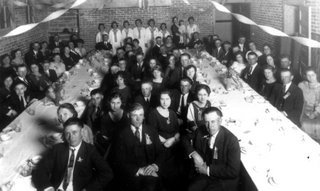 • On March 5, 1935, the Young People’s Society became affiliated with the International Walther League.
• On March 5, 1935, the Young People’s Society became affiliated with the International Walther League.
• In October 1937, St. John Sunday School was organized.
• September of 1940, the congregation formally observed Mr. A.E. Mantey’s 25th anniversary in the teaching profession in a special service with a social hour following.
• In 1941, the 60th Anniversary of St. John congregation was celebrated. On May 11, 1941, 2 services, German and English were conducted by Rev. A. Amstein, former pastor, of San Diego, California. The service in the afternoon was conducted by President A. Schwidder of Fort Dodge, Iowa. 1,000 worshipers attended the services.
• In 1941, Synod’s new hymnal (new Liturgy) was introduced. The Church flag and our Country’s flag were properly mounted and placed into the Church auditorium, a public speaking system was installed in the Church and a Tuesday evening Bible Class for adults was organized.
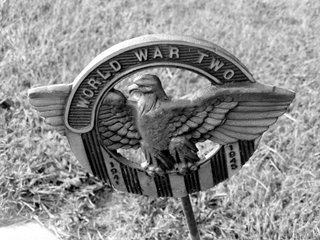 • In 1945, a “Peace Thank-offering” was raised by the congregation for the purpose of sending the saving message of Christ’s Gospel unto many more in this sin-darkened world. WW II had made heavy demands upon us. At one time we had nearly 50 young men in the service of our country. 5 of them gave the supreme sacrifice: Carl Hinrichsen, Vernon Holtorf, Elmer Kuhlmann, Marcus Schmidt and Vernon Schnoor.
• In 1945, a “Peace Thank-offering” was raised by the congregation for the purpose of sending the saving message of Christ’s Gospel unto many more in this sin-darkened world. WW II had made heavy demands upon us. At one time we had nearly 50 young men in the service of our country. 5 of them gave the supreme sacrifice: Carl Hinrichsen, Vernon Holtorf, Elmer Kuhlmann, Marcus Schmidt and Vernon Schnoor.
• During November and December of 1946 the worst epidemic of influenza in decades swept over the community. At one time about one-third of the congregation was stretched low by the same, and over 50% of the children were absent from school. The Lord graciously spared our lives.
_______________________________________
Notice: Are you a member or former member? Are you a former vicar or the family member of a former pastor or vicar?
If you enjoy reading about our history, there's still time to order a book. The 100 page history of St. John's are still on sale. Just call or email the church office and reserve yours today.
Hurry, there will only be a limited number of copies ordered.
Our 125th anniversary celebration will be June 25, 2006
Rev. Doug Schroeder will be preaching at 10 AM worship with music led by "the Kuhlman Sisters."
There will be a BBQ pork sandwich lunch at 11:30 with games and a bounce house for kids.
Rev. Paul Schroeder will preach at a second service at 2 pm
HISTORY OF ST. JOHN
Part 3
• Unfortunately, a burden of debt rested heavily upon the congregation. Interest payments came due regularly and it had become increasingly difficult to meet obligations because of the stress of the times. The years of the depression had been felt deeply by the members of St. John. Add to this fact that in 1934 virtually no crop was harvested, which would be repeated for the next few years. By the grace of God, these difficult years are now a memory. The double envelope system in its entirety was introduced, each communicant member being personally approached for a definite pledge, with the results that in the following January the congregation was able to begin operating on a balanced budget, allowing even for a gradual retirement of the debt.
• The congregation experienced a healthy growth, especially during these last years, thus increasing the financial strength of the congregation.
• It was evident that it was time to introduce more English services with the purpose of holding the younger generation to the church (the children were being confirmed in the English language), and to gain the unchurched in the community whom could not be reached with the German language.
In October 1934, it was resolved that henceforth there would be 2 English and 2 German services each month, alternating on the fifth Sunday. An English service was added for Thanksgiving Day and an English Communion Service on Maundy Thursday. On all the great festivals of the church year 2 services were to be held using both languages. Many were gained for the church by this decision.
• In 1935 members of St. John realizing that it was necessary for the pastor to have a reliable car, which is always ready for an emergency call, gave the pastor substantial financial assistance in buying a new Chevrolet Master Sedan, replacing the old Buick.
 • On March 5, 1935, the Young People’s Society became affiliated with the International Walther League.
• On March 5, 1935, the Young People’s Society became affiliated with the International Walther League.• In October 1937, St. John Sunday School was organized.
• September of 1940, the congregation formally observed Mr. A.E. Mantey’s 25th anniversary in the teaching profession in a special service with a social hour following.
• In 1941, the 60th Anniversary of St. John congregation was celebrated. On May 11, 1941, 2 services, German and English were conducted by Rev. A. Amstein, former pastor, of San Diego, California. The service in the afternoon was conducted by President A. Schwidder of Fort Dodge, Iowa. 1,000 worshipers attended the services.
• In 1941, Synod’s new hymnal (new Liturgy) was introduced. The Church flag and our Country’s flag were properly mounted and placed into the Church auditorium, a public speaking system was installed in the Church and a Tuesday evening Bible Class for adults was organized.
 • In 1945, a “Peace Thank-offering” was raised by the congregation for the purpose of sending the saving message of Christ’s Gospel unto many more in this sin-darkened world. WW II had made heavy demands upon us. At one time we had nearly 50 young men in the service of our country. 5 of them gave the supreme sacrifice: Carl Hinrichsen, Vernon Holtorf, Elmer Kuhlmann, Marcus Schmidt and Vernon Schnoor.
• In 1945, a “Peace Thank-offering” was raised by the congregation for the purpose of sending the saving message of Christ’s Gospel unto many more in this sin-darkened world. WW II had made heavy demands upon us. At one time we had nearly 50 young men in the service of our country. 5 of them gave the supreme sacrifice: Carl Hinrichsen, Vernon Holtorf, Elmer Kuhlmann, Marcus Schmidt and Vernon Schnoor.• During November and December of 1946 the worst epidemic of influenza in decades swept over the community. At one time about one-third of the congregation was stretched low by the same, and over 50% of the children were absent from school. The Lord graciously spared our lives.
_______________________________________
Notice: Are you a member or former member? Are you a former vicar or the family member of a former pastor or vicar?
If you enjoy reading about our history, there's still time to order a book. The 100 page history of St. John's are still on sale. Just call or email the church office and reserve yours today.
Hurry, there will only be a limited number of copies ordered.
Our 125th anniversary celebration will be June 25, 2006
Rev. Doug Schroeder will be preaching at 10 AM worship with music led by "the Kuhlman Sisters."
There will be a BBQ pork sandwich lunch at 11:30 with games and a bounce house for kids.
Rev. Paul Schroeder will preach at a second service at 2 pm
Thank you for your interest in this blog
Pastor A. Amstein

PASTORS AT ST. JOHN, 1.
Pastor A. Amstein was born in Germany, came to America in 1885 and studied at Lutheran Theological Seminary at Springfield, Illinois.
As a student he taught school and preached in Dakota, Davenport and Hanover Township.
After completing his studies at Springfield he accepted a call to Charter Oak and served St. John for 44 years.
He also served as pastor of Immanuel, Soldier Township and St. Paul, Ute for several years.
_______________________________________
Are you a member or former member? Are you a former vicar or the family member of a former pastor or vicar?
If you enjoy reading about our history, there's still time to order a book. The 100 page history of St. John's are still on sale. Just call or email the church office and reserve yours today.
Hurry, there will only be a limited number of copies ordered.
Our 125th anniversary celebration will be June 25, 2006
Rev. Doug Schroeder will be preaching at 10 AM worship with music led by "the Kuhlman Sisters."
There will be a BBQ pork sandwich lunch at 11:30 with games and a bounce house for kids.
Rev. Paul Schroeder will preach at a second service at 2pm
Tuesday, April 25, 2006
St. John's History Part 2
 St. John's History,
St. John's History, Part 2
• St. John congregation, neighboring congregations, and the pastors of the Wall Lake Conference observed Rev. Amstein’s 25th Anniversary in the ministry in a festive manner on August 31, 1915. The local band also honored him.
• On the 20th Sunday after Trinity, 1916, a pipe organ was installed in the church. It was provided with two manuals and 709 pipes and its dimensions were 18 by 12 by 8 feet high. It was driven by an electric motor.
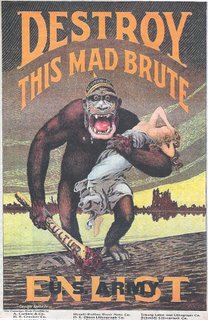 • During the years 1917-1919 (World War I) St. John was greatly harassed by such people who apparently could not and would not believe --- though ever so much testimony and ever so many proofs were offered ---that German-born people or people of German descent could be loyal citizens of the country they had chosen as their permanent home. It was tried in different ways to cast suspicion of disloyalty upon the congregation, its school and especially its young people’s society and to discountenance their manifestations of loyalty to their country. Motives were judged, injustices perpetrated. Those were troublesome days, since the members of St. John, faithful in their duties over against the government, desired nothing more than to enjoy peace with their fellowman, so desirable especially in times of national unrest.
• During the years 1917-1919 (World War I) St. John was greatly harassed by such people who apparently could not and would not believe --- though ever so much testimony and ever so many proofs were offered ---that German-born people or people of German descent could be loyal citizens of the country they had chosen as their permanent home. It was tried in different ways to cast suspicion of disloyalty upon the congregation, its school and especially its young people’s society and to discountenance their manifestations of loyalty to their country. Motives were judged, injustices perpetrated. Those were troublesome days, since the members of St. John, faithful in their duties over against the government, desired nothing more than to enjoy peace with their fellowman, so desirable especially in times of national unrest.• The congregation and its organizations were always vindicated of the charges brought against them. During this time of stress, however, the young people lost their meeting place and the school was condemned.
 • The year 1924 will never be forgotten by those who were affiliated with St. John. On Sunday, September 28, 1924: The pastor was prepared to deliver his message to the people; the members of the congregation were getting ready to go to church or on their way. At nine o’clock or shortly thereafter the electrifying cry rang out: “The Lutheran Church is afire.” It was! In spite of every effort to subdue the flames, in 2½ hours the beautiful church lay in smoking ruins. It had been remodeled, enlarged, and redecorated, only 2 services had been conducted in it since the improvements had been completed, and now – nothing remained of it but eleven pews and the 3 statues: of Christ and of the 2 angels. (These statues are the same ones that beautify our church today). Rev. Amstein wrote concerning the event: “The entire congregation witnessed the tragic drama unfolding before their eyes. It was as if they came together for the purpose of casting a last lingering look upon their house of worship as one takes a last lingering look at a loved one, then to accompany him to his last resting place here on earth. We were much like the children of Israel, who saw their house of worship destroyed and then, in Babylon, as captives complained: ‘By the rivers of Babylon, there we sat down, yea, we wept, when we remembered Zion. We hung our harps upon the willows in the midst thereof.” The origin of the fire remains a mystery to this day.
• The year 1924 will never be forgotten by those who were affiliated with St. John. On Sunday, September 28, 1924: The pastor was prepared to deliver his message to the people; the members of the congregation were getting ready to go to church or on their way. At nine o’clock or shortly thereafter the electrifying cry rang out: “The Lutheran Church is afire.” It was! In spite of every effort to subdue the flames, in 2½ hours the beautiful church lay in smoking ruins. It had been remodeled, enlarged, and redecorated, only 2 services had been conducted in it since the improvements had been completed, and now – nothing remained of it but eleven pews and the 3 statues: of Christ and of the 2 angels. (These statues are the same ones that beautify our church today). Rev. Amstein wrote concerning the event: “The entire congregation witnessed the tragic drama unfolding before their eyes. It was as if they came together for the purpose of casting a last lingering look upon their house of worship as one takes a last lingering look at a loved one, then to accompany him to his last resting place here on earth. We were much like the children of Israel, who saw their house of worship destroyed and then, in Babylon, as captives complained: ‘By the rivers of Babylon, there we sat down, yea, we wept, when we remembered Zion. We hung our harps upon the willows in the midst thereof.” The origin of the fire remains a mystery to this day. • A new church was soon built. The Ladies Aid also provided the funds to transform the basement into a large hall and kitchen. The corner stone was laid on May 24, 1925, and the church was dedicated on February 7, 1926. The weather on dedication day was ideal but the roads were almost impassable. Yet, the church, comfortably seating 650 people, was filled to capacity. (The placing of chairs and the opening of the windows leading to the rear hall made it possible to accommodate about 1,000). The total cost of the church was $62,000.00.
• A new church was soon built. The Ladies Aid also provided the funds to transform the basement into a large hall and kitchen. The corner stone was laid on May 24, 1925, and the church was dedicated on February 7, 1926. The weather on dedication day was ideal but the roads were almost impassable. Yet, the church, comfortably seating 650 people, was filled to capacity. (The placing of chairs and the opening of the windows leading to the rear hall made it possible to accommodate about 1,000). The total cost of the church was $62,000.00.• In August 1927, the District Convention of the Iowa District of the Evangelical Lutheran Church (Missouri Synod) was held in Charter Oak. Some 400 pastors, teachers, and delegates were present.
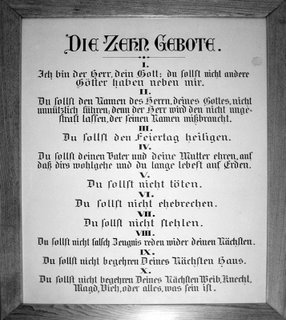
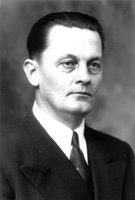 • On July 26, 1934, the congregation extended a call to the Rev. Walter P.A. Schroeder, at the time serving Grace Evangelical Lutheran Congregation of DeWitt, Iowa. After prayerfully considering the importance of the call to St. John, his congregation gave him a peaceful dismissal, which they had been reluctant to do. On September 13, 1934, Rev. Schroeder and his family arrived in Charter Oak. The following Sunday, Rev. Schroeder was installed by Rev. E. Widmann of Ute, Iowa, who had charge of the vacancy. Some 14 pastors took part in the installation service.
• On July 26, 1934, the congregation extended a call to the Rev. Walter P.A. Schroeder, at the time serving Grace Evangelical Lutheran Congregation of DeWitt, Iowa. After prayerfully considering the importance of the call to St. John, his congregation gave him a peaceful dismissal, which they had been reluctant to do. On September 13, 1934, Rev. Schroeder and his family arrived in Charter Oak. The following Sunday, Rev. Schroeder was installed by Rev. E. Widmann of Ute, Iowa, who had charge of the vacancy. Some 14 pastors took part in the installation service.
HISTORY OF ST. JOHN LUTHERAN CHURCH, Part 1
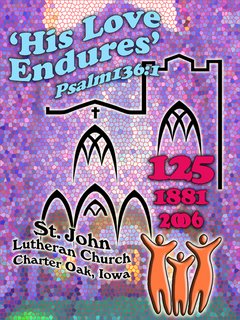 HISTORY OF ST. JOHN LUTHERAN CHURCH
HISTORY OF ST. JOHN LUTHERAN CHURCHPart 1
"The purpose of history is essentially to acquaint us with the heritage of the past, to make us aware of the debt we owe to those who have gone before us, to enable us to profit from the experiences of yesterday."This was the beginning paragraph in the 1941 Sixtieth Anniversary book, and it still applies today.
• The very first settlers of what was soon to be known as Hanover Township, Crawford County, Iowa were Lutherans hailing from the Province of Hanover, Germany. Five families settled there in the fall of 1873. Before the first winter came, they had made arrangements with Rev. G. Haar of Denison, Iowa to minister to them spiritually. Services were conducted in their homes and later in the district schoolhouses.
 In that same decade a number of Lutheran families moved into this territory from Chicago, Illinois. Many of them had emigrated originally from Prussia, Germany. Until 1880 these families had common worship with the original pioneers.
In that same decade a number of Lutheran families moved into this territory from Chicago, Illinois. Many of them had emigrated originally from Prussia, Germany. Until 1880 these families had common worship with the original pioneers.• As a result of a controversy over the location of the contemplated church and cemetery, this group decided it was advisable and best to divide into two separate congregations. This was done with the hopes of building two separate churches in locations that the ever-increasing number of Lutheran families coming would be within easy access of a church. So, St. John Evangelical Lutheran Congregation, comprised of the Lutherans living on the south side of Soldier Creek, was organized on March 13, 1881 under the direction of Rev. G. Haar of Denison. Charter members were: Georg Neddermeyer, Christian Neddermeyer, Friedrich Bockelmann, Georg Schelm, Heinrich Kuhlmann, Georg Kuhlmann and Dietrich Vanier. Two months later the following joined the congregation: Gottfried Henning, Carl Jahn and Heinrich Schroeder. Results of the first election were Christian Neddermeyer and Gottfried Henning – Elders; Christian Neddermeyer –Treasurer; the Rev. G. Haar – Chairman and Secretary.
• Rev. G. Haar served St. John, conducting services in what was long known as Peter Timm’s schoolhouse (one-mile north and 3 miles east of what is now Charter Oak) until 1882 when he accepted a call to Grant Township Church, Ida County. From 1882 to 1889 St. John was served by Rev. C.A. Bretscher from Hanover Township, conducting services every second Sunday, first in Timm’s schoolhouse, and later in Charter Oak. During these years St. John developed rather slowly.
• The members had extreme difficulty agreeing on the exact location for their church. (Must remember the town of Charter Oak was not yet in existence). Acres were bought here and acres were bought there, only to be resold again. The problem was finally settled when the Chicago, Milwaukee and St. Paul Railroad built a line to Sioux City and established the village of Charter Oak in 1887. Several members immediately purchased 2 lots for the congregation. A third lot was presented to the congregation by the Railroad Company with the condition that a church be erected thereon within one year. Soon the members were in full agreement.
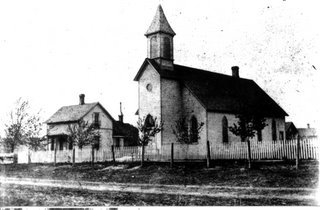 • A church was built in 1888; it was 30 by 50 feet. On October 21, 1888 the 21st Sunday after Trinity, the church was dedicated to the service of the Lord. Rev. W.T. Strobel of Denison conducted the German service in the forenoon, and Rev. M. Herrmann of Grant Township, preached the sermon in the afternoon in the language of the country. Already at this early date the American language was used by St. John Lutheran Church making known the grace of God in Christ Jesus. The church was erected at a total cost of $1,399.00. During this same year the cemetery, one mile north of Charter Oak, was purchased and laid out in lots.
• A church was built in 1888; it was 30 by 50 feet. On October 21, 1888 the 21st Sunday after Trinity, the church was dedicated to the service of the Lord. Rev. W.T. Strobel of Denison conducted the German service in the forenoon, and Rev. M. Herrmann of Grant Township, preached the sermon in the afternoon in the language of the country. Already at this early date the American language was used by St. John Lutheran Church making known the grace of God in Christ Jesus. The church was erected at a total cost of $1,399.00. During this same year the cemetery, one mile north of Charter Oak, was purchased and laid out in lots.• Candidate Amstein was ordained and installed in St. John’s congregation on August 31, 1890, and also installed in the Soldier Township congregation.
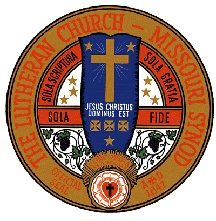 • In 1891 the first parsonage was built and then was enlarged in 1896.
• In 1891 the first parsonage was built and then was enlarged in 1896.• In 1892 St. John congregation joined the Evangelical Lutheran Synod of Missouri, Ohio, and other states.
• In 1902, a school was built since the schoolroom in the rear of the church had become too small to accommodate the large number of children. The dimensions of the school were 22 by 36 feet with a hall 8 by 8 feet.
• The congregation decided to erect a new church: 30 by 64 feet with an 80-foot tower. Rev. A. Amstein delivered the address on the laying of the cornerstone on July 14, 1907, in the absence of Rev. C. Wehking who was ill. The building committee consisted of Messrs. George Schelm, Carl Schreiber, Franz Riedesel and Paul Fiene. In the corner-stone prepared by Mr. Conrad Broesamle, were placed a hymn book, a catechism, history of the congregation, a copy of the current issue of the Charter Oak Times, Crawford county Demokrat, Kirchliche Nachrichten, and Der Lutheraner. After the congregation met in the City Hall for nearly a year, they rejoiced when they were able to worship in their own house on March 29, 1908, the day of dedication. The speakers were Revs. C. Runge, H. Wehking and Wm. Frese (English). Dinner and luncheon were served to all members and guests. The entire cost of this building program was $12,000.00.
Subscribe to:
Posts (Atom)
